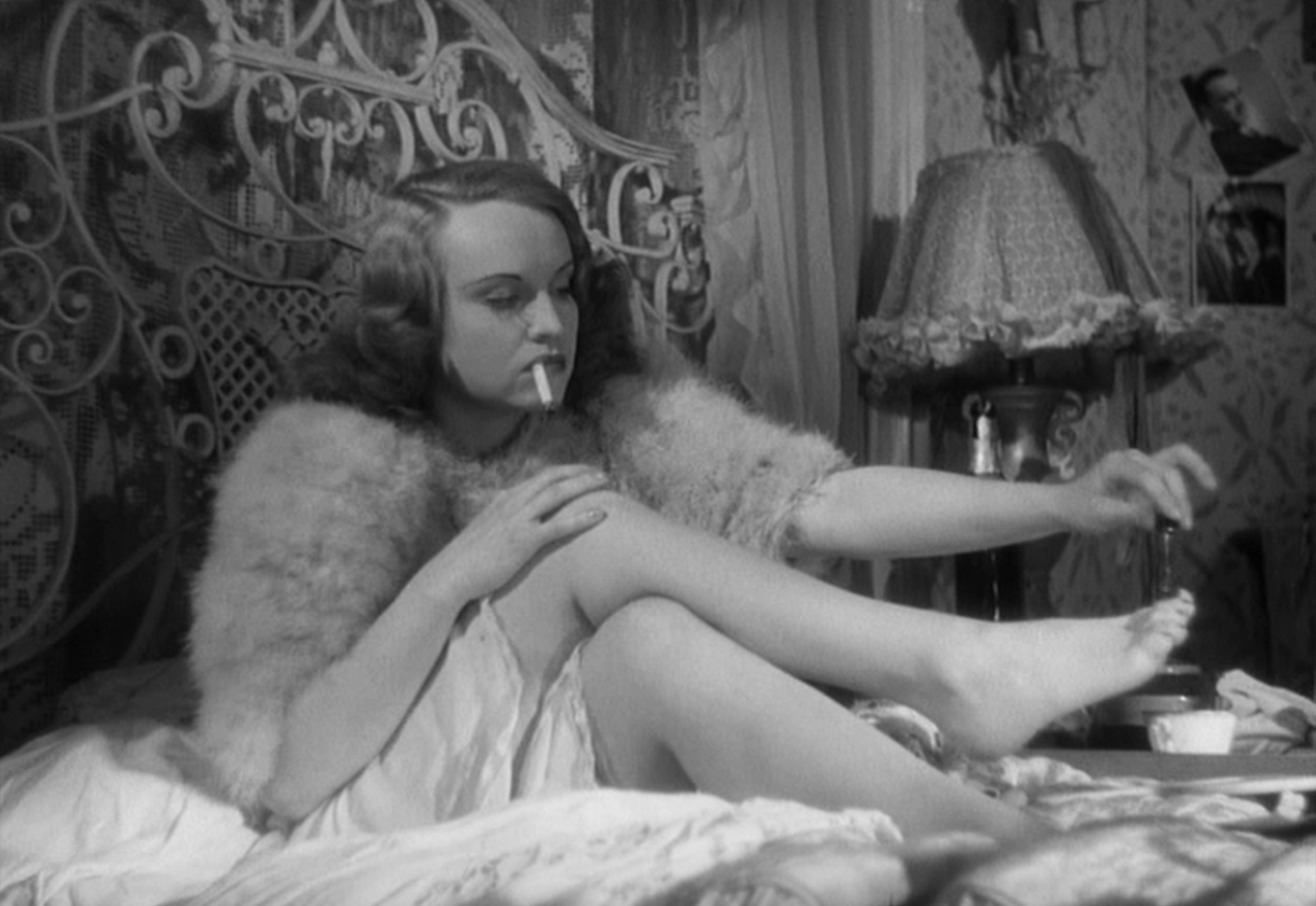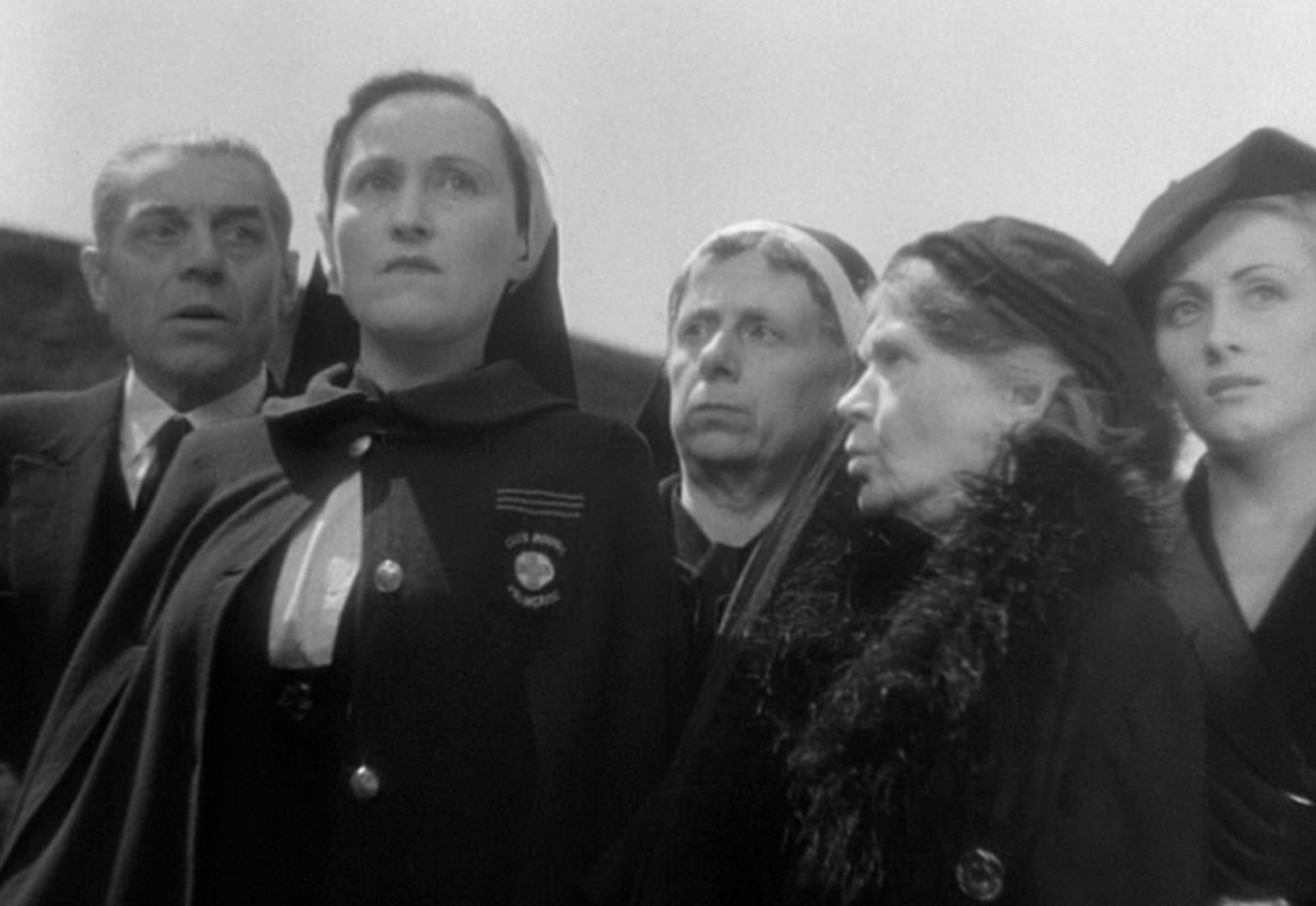LE CORBEAU





3:15 PM, Sat October 16
Classic Cinemas, Elsternwick
Introduced by Mark Thomas
Director: Henri-Georges Clouzot
Country: France
Year: 1943
Runtime: 92 minutes
Language: French, with English subtitles
Format: B&W, 2K DCP (originally 35mm)
Rating: PG
Classic Cinemas, Elsternwick
Introduced by Mark Thomas
Director: Henri-Georges Clouzot
Country: France
Year: 1943
Runtime: 92 minutes
Language: French, with English subtitles
Format: B&W, 2K DCP (originally 35mm)
Rating: PG
Tickets⟶
“[A]
starkly realist portrayal of a small provincial community…the most vivid and
corrosive picture of Nazi-controlled France.” — James
Travers, frenchflms.org
The Nazi German-controlled Continental Films sought to hire the best of the Occupied France film industry. Among those who accepted the offer was the young director, Henri-Georges Clouzot. Of the thirty films made by the company, Le Corbeau is regarded as the finest, and also as Clouzot’s first, if controversial masterpiece. The film gives full vent to the dark misanthropy that would be a hallmark of the director’s career.
Source: StudioCanal
Introduced by John McDonald
The Nazi German-controlled Continental Films sought to hire the best of the Occupied France film industry. Among those who accepted the offer was the young director, Henri-Georges Clouzot. Of the thirty films made by the company, Le Corbeau is regarded as the finest, and also as Clouzot’s first, if controversial masterpiece. The film gives full vent to the dark misanthropy that would be a hallmark of the director’s career.
Source: StudioCanal
Introduced by John McDonald
Notes by Mark Pierce:
Henri-Georges Clouzot
“Clouzot (1907-77) began his career with two thrillers made during the
Occupation; L’Assassin Habite au 21 (9142) and Le
Corbeau (The Raven, 1943)… For
whatever reason, Clouzot was never again to equal the promise of the ferocious Le Corbeau. Quai des Orfèvres (1947) was an entertaining thriller
starring the delightfully improbable couple of Louis Jouvet and Suzy Delair; Manon (1949), an updating of the Manon
Lescaut story, had its moments. His most successful film in box office terms
was of course the world-famous Le Salaire
de la Peur (Wages of Fear, 1953), which squeezed every drop of suspense out
of the hackneyed story of three men transporting a load of nitroglycerine
across the mountains. Les Diaboliques (1955) was a successful thriller; Le Mystère Picasso (1956), an oddity about the painter had a succès d’estime; La Vérité (The Truth, 1960)
starring Brigitte Bardot, was his last film of any importance. Clouzot was
dogged with illness and did not work after 1969.” (Richard Roud, extracted and adapted
from the entry on René Clément and Henri-Georges Clouzot in “Cinema: A Critical
Dictionary”, Secker & Warburg, 1980)
Continental Films
Continental Films was a German-controlled French film production
company. Established in October 1940, it was entirely bankrolled by the German
government, and headed by Alfred Greven in Paris, with its finances,
production and distribution tightly integrated with the German film industry. Continental
released 30 features before ending production four years later.
Alfred Greven
The
director of Continental Films was the German producer Alfred Greven (1897-1973).
He volunteered in September 1914 for the German Army and was awarded the
Iron Cross.
After the war he started to work in the movie business in 1920, joining the Nazi Party in 1931. In 1940, Goebbels appointed him managing director of the newly established Continental Films.
After the war he started to work in the movie business in 1920, joining the Nazi Party in 1931. In 1940, Goebbels appointed him managing director of the newly established Continental Films.
The Film
In 1994 I was
privileged to attend the fiftieth anniversary celebrations of the liberation of
Paris. The French were not simply
commemorating the day on which the German army decided to retreat without
blowing up Paris’ historical monuments. Many French women and men were
liberating themselves from the national shame and guilt at France’s precipitate
collapse in 1940, its tolerance of Nazi rule, its readiness to hand over French
Jews and the collaboration which pervaded French society. Le Corbeau helps explain why those wounds remained so raw for so
long.
In French, a “corbeau” refers either to a crow or a raven. Both are sinister birds of prey, both feast on carrion, both bear Gestapo-black plumage. The metaphor is apposite for a film suffused with ambiguities, deceptions and subterfuge. Most scenes in Le Corbeau seem cast in deep shadows.
Le Corbeau is set in “une petite ville, ici ou ailleurs”, “a little village, here or elsewhere”, which we might understand as anywhere at all. This village is a particularly seedy, sordid spot; the villagers serve as their own gaolers, their neighbourhood as their own prison.
Although the director, Henri-Georges Clouzot, starts with shots of the local cemetery and church, neither place offers any solace for the inhabitants. Those images – emblems signifying tradition, community, resilience and conviction – have always been the staple, comforting, never-changing clichés in French depictions of their countryside. The opening scene in Le Corbeau could have been cut and pasted into Francois Mitterrand’s campaign poster, proclaiming “La Force Tranquille”, for the Presidential elections he won in 1981.
In Clouzot’s village, however, the locals would never take a punt on a secular, reforming ex-socialist. The locals seem devoid of peace or faith, calm or purpose. For its part, the rest of their village looks a lot like the hollowed-out, shuttered-up little towns which now disfigure parts of the French landscape. Those villages are claustrophobically turned inwards and backwards, as is the one which Clouzet created.
The pivot of Le Corbeau is a series of anonymous, clumsily written denunciations. To begin with, the village doctor is accused of being a jester, a thief, a liar and an abortionist, a beguilingly eclectic set of sins. That man, Dr Germain (played in dapper clothes with lacquered hair by Pierre Fresnay) has already been accused of falsifying his medical credentials. His travails, though, have barely begun. If the premise of denunciations appears implausible, it is worth recalling that more than nine tenths of Gestapo arrests in Germany stemmed from denunciations. Occupied countries were still more complicit in a surveillance society of the soul. Dobbing is a universal vice.
Clouzot builds up a feeling of foreboding not entirely unlike that to be found now in Nordic noir. An exorcist, an axe murderer or a giant wolf could readily be found prowling the streets of this village. Eerie, disorientating incidents are littered throughout the narrative. An odd, bespectacled girl bounces a ball indoors before resorting to spying through key holes. A heavily lacquered hypochondriac flashes her bare thighs, then her bare back, at the viewers. The same woman later rummages in attic trunk to unearth a stuffed “corbeau”. Clouzot does not shrink from stating the obvious, nor from simplifying and exaggerating his effects. A few of the characters evoke rats rather than ravens.
Le Corbeau does not provide any compelling or comprehensive account of France under the Occupation. That would be too much to ask. The film was released in 1943, and decades elapsed before the French produced a documentary account of their war, Le Chagrin et La Pitie, (Marcel Ophuls, 1969) let alone feature films like Lacombe Lucien (Louis Malle, 1974) or Au Revoir les Enfants (Louis Malle, 1987). Each of those films concerns itself with confronting moral dilemmas and the sense of menace they engender, rather than, as with Clouzot, with amorphous, anonymous threats from someone unknown.
The exceptional ensemble performances in the television drama Un Village Français (created by Emmanuel Daucé, Frédéric Krivine and Philippe Triboit, 2009-17) began to appear only 66 years after Clouzot’s film. Dealing with disasters, humiliations and disgrace of the order visited on France takes a long time to absorb and to transform into a story, whether in print or on film. We have seen the enemy, and he is us.
Moreover, Clouzot’s film was produced by Continental Films Paris, which might as well have been titled Collaboration Films. The Nazi-run company turned out thirty feature films between the occupation of Paris (1940) and its liberation four years later. Perversely the last product of this tainted studio concerned the cellars of a hotel. Hotel cellars were one of the Gestapo’s regular haunts for detaining and torturing Resistance fighters. One of Paris’ prestigious hotels served as their headquarters.
Straight after its release in 1943, nobody seemed to hold Le Corbeau in high regard. Some figures in the Resistance apparently condemned the film as propaganda, while the Germans themselves thought the work was not propagandist enough. As for Clouzot, after the Liberation he was banned from making another film, but for a mere two years. Given the summary punishments associated with “l’épuration”, the cleansing, in France, that was a pretty soft judgment. Even misguided or unbalanced Anglo-Saxon collaborators, the likes of PG Wodehouse and Ezra Pound, suffered far more severe obloquy. Their reputations remain tarnished by their sorry behaviour during the war. Clouzet went on to direct a tauter, sharper film, Quai des Orfèvres, with his title referring to the building which Inspector Maigret has made famous. Le Corbeau, the film itself, was ostracised for much longer than was its director.
Maigret dealt in all possible shades of grey, Clouzot in a consistently darker, grimmer palette. Film noir might claim him as one of its own. Le Corbeau might have outlived critics contending that it was ironic for Clouzot to produce a film about moral weakness and cowardice in a State and studio structure built precisely on exploiting those qualities. To say the film is flawed may be redundant, since its impact depends on the flaws inherent in its characters and the times they tried to survive.
In French, a “corbeau” refers either to a crow or a raven. Both are sinister birds of prey, both feast on carrion, both bear Gestapo-black plumage. The metaphor is apposite for a film suffused with ambiguities, deceptions and subterfuge. Most scenes in Le Corbeau seem cast in deep shadows.
Le Corbeau is set in “une petite ville, ici ou ailleurs”, “a little village, here or elsewhere”, which we might understand as anywhere at all. This village is a particularly seedy, sordid spot; the villagers serve as their own gaolers, their neighbourhood as their own prison.
Although the director, Henri-Georges Clouzot, starts with shots of the local cemetery and church, neither place offers any solace for the inhabitants. Those images – emblems signifying tradition, community, resilience and conviction – have always been the staple, comforting, never-changing clichés in French depictions of their countryside. The opening scene in Le Corbeau could have been cut and pasted into Francois Mitterrand’s campaign poster, proclaiming “La Force Tranquille”, for the Presidential elections he won in 1981.
In Clouzot’s village, however, the locals would never take a punt on a secular, reforming ex-socialist. The locals seem devoid of peace or faith, calm or purpose. For its part, the rest of their village looks a lot like the hollowed-out, shuttered-up little towns which now disfigure parts of the French landscape. Those villages are claustrophobically turned inwards and backwards, as is the one which Clouzet created.
The pivot of Le Corbeau is a series of anonymous, clumsily written denunciations. To begin with, the village doctor is accused of being a jester, a thief, a liar and an abortionist, a beguilingly eclectic set of sins. That man, Dr Germain (played in dapper clothes with lacquered hair by Pierre Fresnay) has already been accused of falsifying his medical credentials. His travails, though, have barely begun. If the premise of denunciations appears implausible, it is worth recalling that more than nine tenths of Gestapo arrests in Germany stemmed from denunciations. Occupied countries were still more complicit in a surveillance society of the soul. Dobbing is a universal vice.
Clouzot builds up a feeling of foreboding not entirely unlike that to be found now in Nordic noir. An exorcist, an axe murderer or a giant wolf could readily be found prowling the streets of this village. Eerie, disorientating incidents are littered throughout the narrative. An odd, bespectacled girl bounces a ball indoors before resorting to spying through key holes. A heavily lacquered hypochondriac flashes her bare thighs, then her bare back, at the viewers. The same woman later rummages in attic trunk to unearth a stuffed “corbeau”. Clouzot does not shrink from stating the obvious, nor from simplifying and exaggerating his effects. A few of the characters evoke rats rather than ravens.
Le Corbeau does not provide any compelling or comprehensive account of France under the Occupation. That would be too much to ask. The film was released in 1943, and decades elapsed before the French produced a documentary account of their war, Le Chagrin et La Pitie, (Marcel Ophuls, 1969) let alone feature films like Lacombe Lucien (Louis Malle, 1974) or Au Revoir les Enfants (Louis Malle, 1987). Each of those films concerns itself with confronting moral dilemmas and the sense of menace they engender, rather than, as with Clouzot, with amorphous, anonymous threats from someone unknown.
The exceptional ensemble performances in the television drama Un Village Français (created by Emmanuel Daucé, Frédéric Krivine and Philippe Triboit, 2009-17) began to appear only 66 years after Clouzot’s film. Dealing with disasters, humiliations and disgrace of the order visited on France takes a long time to absorb and to transform into a story, whether in print or on film. We have seen the enemy, and he is us.
Moreover, Clouzot’s film was produced by Continental Films Paris, which might as well have been titled Collaboration Films. The Nazi-run company turned out thirty feature films between the occupation of Paris (1940) and its liberation four years later. Perversely the last product of this tainted studio concerned the cellars of a hotel. Hotel cellars were one of the Gestapo’s regular haunts for detaining and torturing Resistance fighters. One of Paris’ prestigious hotels served as their headquarters.
Straight after its release in 1943, nobody seemed to hold Le Corbeau in high regard. Some figures in the Resistance apparently condemned the film as propaganda, while the Germans themselves thought the work was not propagandist enough. As for Clouzot, after the Liberation he was banned from making another film, but for a mere two years. Given the summary punishments associated with “l’épuration”, the cleansing, in France, that was a pretty soft judgment. Even misguided or unbalanced Anglo-Saxon collaborators, the likes of PG Wodehouse and Ezra Pound, suffered far more severe obloquy. Their reputations remain tarnished by their sorry behaviour during the war. Clouzet went on to direct a tauter, sharper film, Quai des Orfèvres, with his title referring to the building which Inspector Maigret has made famous. Le Corbeau, the film itself, was ostracised for much longer than was its director.
Maigret dealt in all possible shades of grey, Clouzot in a consistently darker, grimmer palette. Film noir might claim him as one of its own. Le Corbeau might have outlived critics contending that it was ironic for Clouzot to produce a film about moral weakness and cowardice in a State and studio structure built precisely on exploiting those qualities. To say the film is flawed may be redundant, since its impact depends on the flaws inherent in its characters and the times they tried to survive.
Full film details:
The Restoration
Restoration
by StudioCanal in 2018 with newly translated English subtitles.
France | 1943 | 92 mins | B&W | Sound | DCP (orig 35mm) | French with English subtitles | PG
Dir: Henri Georges CLOUZOT | Prod Co: Continental Films | Prod: Raoul PLOQUIN, René MONTIS | Scr: Louis CHAVANCE, Henri-Georges CLOUZOT | Photo: Nicholas HAYER | Edit: Marguerite BEAUGÉ | Des: André ANDREJEW | Sound: William Robert SIVEL | Music: Tony AUBIN
Cast: Pierre FRESNAY (Dr Remy Germain), Ginette LECLERC (Denise Saillens), Micheline FRANCEY (Laura Vorzet), Héléna MANSON (Marie Corbin, the nurse)
France | 1943 | 92 mins | B&W | Sound | DCP (orig 35mm) | French with English subtitles | PG
Dir: Henri Georges CLOUZOT | Prod Co: Continental Films | Prod: Raoul PLOQUIN, René MONTIS | Scr: Louis CHAVANCE, Henri-Georges CLOUZOT | Photo: Nicholas HAYER | Edit: Marguerite BEAUGÉ | Des: André ANDREJEW | Sound: William Robert SIVEL | Music: Tony AUBIN
Cast: Pierre FRESNAY (Dr Remy Germain), Ginette LECLERC (Denise Saillens), Micheline FRANCEY (Laura Vorzet), Héléna MANSON (Marie Corbin, the nurse)
